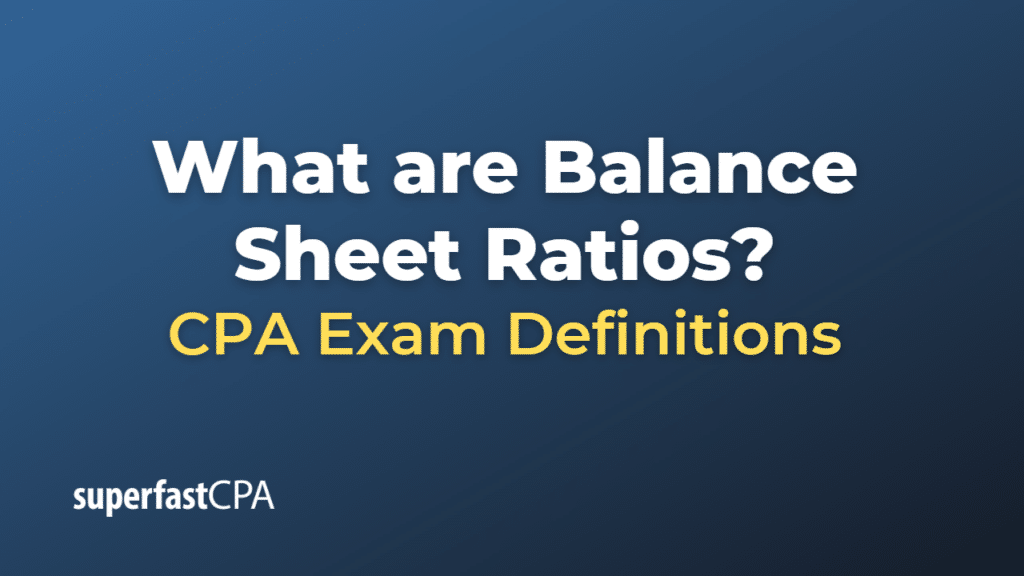Balance Sheet Ratios
Balance sheet ratios are financial metrics calculated using data from a company’s balance sheet. These ratios help analysts, investors, and creditors evaluate a company’s financial health, liquidity, solvency, and overall performance. Some common balance sheet ratios include:
- Current Ratio: Measures a company’s ability to pay its short-term obligations using its short-term assets.
- \(\text{Current Ratio} = \frac{\text{Current Assets}}{\text{Current Liabilities}} \)
- Quick Ratio (Acid-Test Ratio): Assesses a company’s ability to pay its short-term obligations using its most liquid assets, excluding inventory.
- \(\text{Quick Ratio} = \frac{\text{Current Assets – Inventory}}{\text{Current Liabilities}} \)
- Debt to Equity Ratio: Indicates the proportion of a company’s financing that comes from debt relative to equity.
- \(\text{Debt to Equity Ratio} = \frac{\text{Total Liabilities}}{\text{Total Equity}} \)
- Equity Ratio: Shows the proportion of a company’s total assets financed by shareholders’ equity.
- \(\text{Equity Ratio} = \frac{\text{Total Equitys}}{\text{Total Assets}} \)
- Debt Ratio: Represents the proportion of a company’s total assets financed by debt.
- \(\text{Debt Ratio} = \frac{\text{Total Liabilities}}{\text{Total Assets}} \)
- Working Capital: Demonstrates the difference between a company’s current assets and current liabilities.
- \(\text{Working Capital} = \text{Current Assets – Current Liabilities}\)
- Return on Equity (ROE): Measures the profitability of a company in relation to shareholders’ equity.
- \(\text{Return on Equity} = \frac{\text{Net Income}}{\text{Total Equity}} \)
- Return on Assets (ROA): Evaluates a company’s ability to generate profits from its total assets.
- \(\text{Return on Assets} = \frac{\text{Net Income}}{\text{Total Assets}} \)
These ratios provide valuable insights into a company’s financial position and can be used for comparison with other companies or industry benchmarks.
Example of Balance Sheet Ratios
Let’s consider a hypothetical company, XYZ Corp, with the following balance sheet figures:
Current Assets: $200,000 Inventory: $50,000 Current Liabilities: $100,000 Total Liabilities: $300,000 Total Equity: $200,000 Total Assets: $500,000 Net Income: $80,000
Now, we can calculate some balance sheet ratios for XYZ Corp:
- \(\text{Current Ratio} = \frac{\text{Current Assets}}{\text{Current Liabilities}} \)
\(\text{Current Ratio} = \frac{200,000}{100,000} = 2.0 \) - \(\text{Quick Ratio} = \frac{\text{Current Assets – Inventory}}{\text{Current Liabilities}} \)
\(\text{Quick Ratio} = \frac{200,000 – 50,000}{100,000} = 1.5 \) - \(\text{Debt to Equity Ratio} = \frac{\text{Total Liabilities}}{\text{Total Equity}} \)
\(\text{Debt to Equity Ratio} = \frac{300,000}{200,000} = 1.5 \) - \(\text{Equity Ratio} = \frac{\text{Total Equitys}}{\text{Total Assets}} \)
\(\text{Equity Ratio} = \frac{200,000}{500,000} = 0.4 \) - \(\text{Debt Ratio} = \frac{\text{Total Liabilities}}{\text{Total Assets}} \)
\(\text{Debt Ratio} = \frac{300,000}{500,000} = 0.6 \) - \(\text{Working Capital} = \text{Current Assets – Current Liabilities}\)
\(\text{Working Capital} = 200,000 – 100,000 = 100,000 \) - \(\text{Return on Equity} = \frac{\text{Net Income}}{\text{Total Equity}} \)
\(\text{Return on Equity} = \frac{80,000}{200,000} = 0.4 \text{ or 40%} \) - \(\text{Return on Assets} = \frac{\text{Net Income}}{\text{Total Assets}} \)
\(\text{Return on Assets} = \frac{80,000}{500,000} = 0.16 \text{ or 16%} \)
By calculating these ratios, we get a better understanding of XYZ Corp’s financial health and performance. For example, the current ratio of 2.0 indicates that XYZ Corp has enough current assets to cover its current liabilities twice, suggesting good short-term liquidity. The debt to equity ratio of 1.5 means the company has 1.5 times more debt than equity, which could be a concern for investors depending on the industry and company size.













